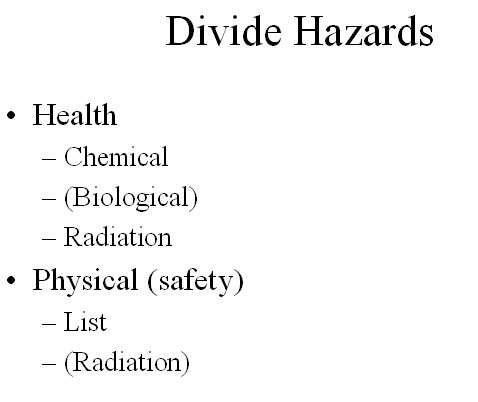
Workplace safety.
Workplace (OSHA) health standards are different than environmental (EPA) standards. For example:
|
Chemical Name
|
Environmental Standards (mg/m3)
|
OSHA Std (mg/m3)
|
|
Carbon monoxide
|
10.4 | 58 |
|
Styrene
|
1 | 425 |
|
Carbon disulfide
|
0.7 | 62 |
Note the workplace standard for styrene is 425-fold less strict than the environmental standard. Why?
|
Factor
|
Workplace / Worker
|
Environmental
|
|
Age and Health of Subject
|
Assumed healthy adult | May be very young, old, sick |
|
Duration of Exposure
|
2000 hours per year, 30 years | 24 hours, 365 days, 70 years |
|
Compensation
|
Paid for work | No compensation |
|
Risk
|
Some "reasonable" risks accepted | No "real" risk tolerated. |
Workplace hazards are often divided:

Adverse health effects, are called "illnesses." Adverse physical (safety) effects are called "injuries." The events that caused the illness are not obvious nor is the time they occurred, which may have been months or years prior to the patient manifestation of the illness. Or the illness might have been caused by a series of events over time. Injuries occur at a definite time and place. They usually involve a sudden release of energy.
Health hazards are the domain of the industrial hygienist and safety hazards are the domain of the "safety professional." In most states, legally, and in all states, as a practical matter, anyone can call themselves either or both names. The American Board of Industrial Hygiene controls the "Certified Industrial Hygienist" and "CIH" titles. In order to become a CIH one needs a 4-year college degree in engineering, chemistry, or other hard science field, 5 years of industrial hygiene experience, and must pass two 8-hour written exams. There are 15 CIH's in Alaska. The American Society of Safety Engineers controls the title "Certified Safety Professional" and "CSP." There are very few engineers in the "Safety Engineers," and there are no firm requirements for a scientific education or background for the CSP title. There is an experience and examination requirement.
We have not talked much about biological hazards, bacteria and viruses. Bears are usually included in Safety hazards. Radiation is considered a health hazard.
Since 1970 the Occupational Safety and Health Administration (OSHA) has been administrating federal laws that provide for workplace safety. Certain states have approval from OSHA to administer their own state safety and health programs, Alaska is one of these. The states must promulgate their own regulations that are no less stringent (protective of workers) than the federal regulations. Alaska has adopted the federal regulations en mass, and only added a few of their own.
An important concept is who is regulated by OSHA. OSHA is all about employers providing a safe workplace for employees. OSHA cannot fine a worker, foreman or anyone but an employer. "Students" and bystanders are not employees. Also not covered by OSHA are employees of state and local governments. As a practical mater, all governments have adopted laws to protect government employees.
For risk assessors, the most important OSHA regulation is the Hazard Communication Standard. (29 CFR 1910.120).The essence of the "Haz Comm" regulation is that employers must inform their employees about chemical hazards in the workplace and provide proper training regarding these hazards. A vital part of Haz Comm is the requirement that all manufacturers and importers of chemicals used in commerce must provide a Material Safety Data Sheet (MSDS) and that the employer must provide these MSDS sheets to the employees. Here's an MSDS sheet for carbon disulfide. Note the major subject headings. In 2012 OSHA changed the name for MSDS to SDS, Safety Data Sheets, and tightened the regulations somewhat. You can go to this section of another course to read more, and the use your BACK button to return here. (Just the top of this site.) . MSDS/SDS However the term "MSDS" is still common.
Some important facts (in Perkins opinion) about MSDS sheets:
Also important is the HAZWOPER training. That stands for Hazardous Waste Operations and Emergency Response. It is a requirement for workers at certain hazardous waste operations to have 40 hours training before they are exposed. There are many details and some exceptions, for people who are only at sites briefly. I won't go into any details, but IF YOU ARE WORKING WITH HAZARDOUS MATERIAL OR ON HAZARDOUS WASTE SITES, YOU NEED TO BE TRAINED. It is your employer's obligation to provide that training.
End of Submodule 12D.